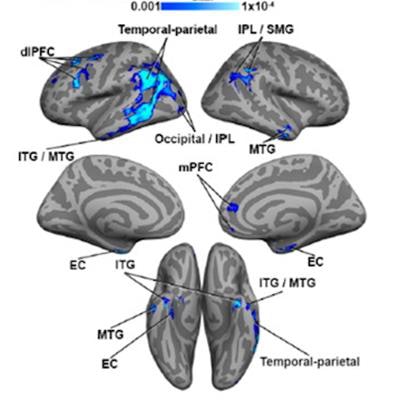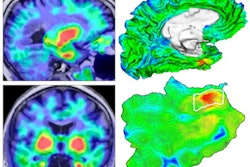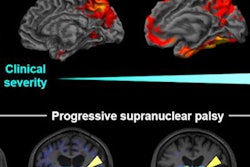
Using MR and PET imaging, researchers from the University of Southern California (USC) in Los Angeles have found a connection between impaired blood flow to the brain and tau protein buildup in patients with Alzheimer's disease (AD), according to a study published October 12 in the Journal of Neuroscience.
This connection indicates that a two-pronged approach to Alzheimer's disease treatment may be effective, wrote a team led by Daniel Albrecht, PhD.
"Our results ... suggest that early vascular-tau associations are exacerbated in the presence of amyloid, consistent with a two-hit model of Alzheimer's disease on cognition," the authors wrote. "Combination treatments targeting vascular health, as well as [beta-amyloid] and tau levels, may preserve cognitive function more effectively than single-target therapies."
Studies have shown that as Alzheimer's disease progresses, cerebral blood flow decreases and beta-amyloid and tau levels increase, the group noted. But despite these findings, the connection between vascular dysfunction and tau pathology and their effects on cognition isn't well understood, according to Albrecht and colleagues.
"Like the proverbial chicken and egg, it remains unclear if impaired blood flow causes or is caused by errant protein buildup, or if the two symptoms occur for unrelated reasons," the researchers said in a statement released by the Society for Neuroscience, publisher of the journal.
To examine this connection, Albrecht's team used MRI to assess cerebral blood flow and PET to assess beta-amyloid and tau levels in 68 USC patients and a validation group that consisted of 138 patients who participated in the Alzheimer's Disease Neuroimaging Initiative. Each participant underwent neuropsychological testing for attention and executive brain function and memory, as well as both MR and PET imaging.
Albrecht's team found that areas of the brain with higher tau levels had diminished blood flow -- particularly in the inferior temporal gyrus, which is often the first to show tau buildup in Alzheimer's disease.
 Brain regions with a negative correlation between blood flow and tau. Alzheimer's disease and mild cognitive impairment (AD-MCI) on the left, cognitively normal (CN) on the right. Image courtesy of Albrecht et al and the Journal of Neuroscience.
Brain regions with a negative correlation between blood flow and tau. Alzheimer's disease and mild cognitive impairment (AD-MCI) on the left, cognitively normal (CN) on the right. Image courtesy of Albrecht et al and the Journal of Neuroscience."The correlation between tau and vascular function was stronger in people with greater cognitive impairment and higher [beta-amyloid] levels," the society said in its statement. "It also appeared in more brain regions as the disease progressed in severity."
| Correlation between blood flow and beta amyloid and cognitive impairment | ||||||
| Measure | Cognitively healthy patients | Patients at risk of mild cognitive impairment | Mild cognitive impairment | Cognitively healthy patients | Patients with mild cognitive impairment | Patients with Alzheimer's disease |
| Cerebral blood flow1 | 40.4 | 41 | 40.1 | 48.3 | 43.5 | 40.7 |
| Cognitive health2 | 28.3 | 26.5 | 20.3 | 25.8 | 23.2 | 17.8 |
| Amyloid burden3 | 13.1 | 17.1 | 59.6 | 20.9 | 31.9 | 89.7 |
2As measured by the Montreal Cognitive Assessment; lower values = less health
3Higher values = increased burden
The study indicates that targeting vascular function could be key to treating Alzheimer's dementia, according to Albrecht and colleagues.
"Results from the current study provide the first evidence of associations between elevated tau PET signal and vascular dysfunction," they concluded. "Combination treatments targeting vascular health, as well as [beta-amyloid] and tau levels, may be more effective in preserving cognitive function than single-target therapies."





















